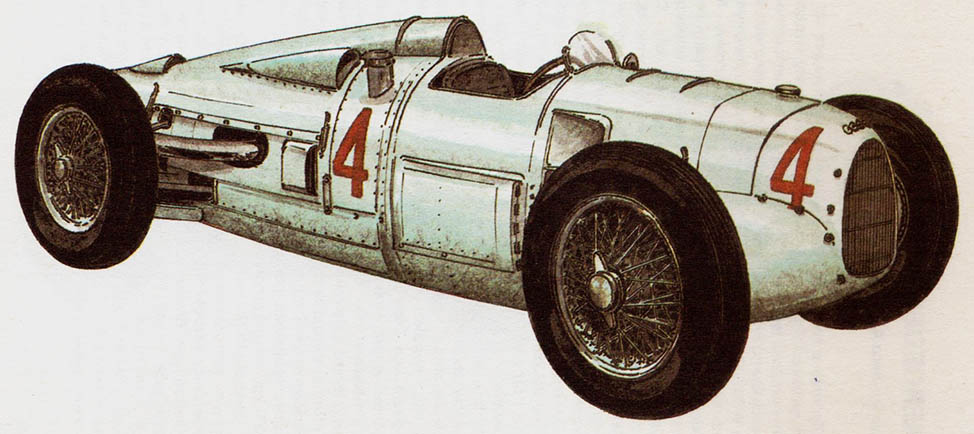AUTO UNION C – year 1937
AutoUnion AG, Zwickau, Germany.
From 1934 year, as a result of refinement, the displacement and power of the Auto Union engines gradually increased. Model C produced in 1936 years had a sixteen-cylinder engine with a capacity of 6010 cm3 (∅ 75 x 85 mm). Boost pressure increased to 195 kPa. Compression ratio engine 9,2 : 1 he achieved incredible power 382,7 kW (520 KM) by 5000 RPM. The crankshaft, composed of parts connected by a Hirth gear and mounted in rolling bearings, has been adapted to this. Driving power was transferred from the engine via a disc clutch to a four-speed gearbox located behind the rear axle. From there, the drive returned to the ZF differential. Due to this design, it was possible to exclude the connecting shaft. The rear oscillating shafts were suspended on longitudinal torsion bars, placed in the frame tubes. Leveraged friction dampers were used for depreciation. The tubular frame also circulated the water from the radiator to the engine and back again. However, the Model C uses separate cables for this purpose after unsuccessful attempts with the Model A. Lockheed hydraulic drum brakes acted on all wheels. Model C had a wheelbase extended from 2800 do 2900 mm, but the overall length truncated from 4550 do 3920 mm. This car reached the top speed 340 km/h, making it the fastest Grand Prix racing car at the time.

AutoUnion AG, Zwickau, Germany.
W 1936 year driver of Auto Union – Bernd Rosemeyer – won the German Grand Prix (130,9 km/h), Switzerland (160,7 km/h) and Italy (135,3 km/h). In addition, he won a laurel wreath at the Eifelrennen races, Nurburgring i Coppa Acerbo w Pescara. The following year, Auto Union won first or second places at the Belgian Grand Prix (1 place Rudolf Hasse, 167,8 km/h), w Donington (1 Rosemeyer place, 132,6 km/h) and the Tripoli Grand Prix (2 Rosemeyer place).